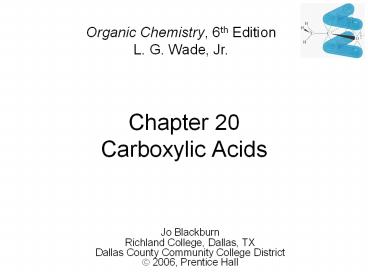Chapter 20 Carboxylic Acids PowerPoint PPT Presentation
1 / 39
Title: Chapter 20 Carboxylic Acids
1
Chapter 20Carboxylic Acids
Organic Chemistry, 6th EditionL. G. Wade, Jr.
Jo Blackburn Richland College, Dallas, TX Dallas
County Community College District ã 2006,
Prentice Hall
2
Introduction
- Carbonyl (-CO) and hydroxyl (-OH) on the same
carbon is carboxyl group. - Carboxyl group is usually written -COOH.
- Aliphatic acids have an alkyl group bonded to
-COOH. - Aromatic acids have an aryl group.
- Fatty acids are long-chain aliphatic acids.
3
Common Names
- Many aliphatic acids have historical names.
- Positions of substituents on the chain are
labeled with Greek letters.
4
IUPAC Names
- Remove -e from alkane (or alkene) name, add -oic
acid. - The carbon of the carboxyl group is 1.
2-chlorobutanoic acid
5
Naming Cyclic Acids
- Cycloalkanes bonded to -COOH are named as
cycloalkanecarboxylic acids. - Aromatic acids are named as benzoic acids.
o-hydroxybenzoic acid (salicylic acid)
gt
2-isopropylcyclopentanecarboxylic acid
6
Dicarboxylic Acids
- Aliphatic diacids are usually called by their
common names (to be memorized). - For IUPAC name, number the chain from the end
closest to a substituent. - Two carboxyl groups on a benzene ring indicate a
phthalic acid.
7
Structure of Carboxyl
- Carbon is sp2 hybridized.
- Bond angles are close to 120?.
- O-H eclipsed with CO, to get overlap of ?
orbital with orbital of lone pair on oxygen.
8
Boiling Points
- Higher boiling points than similar alcohols, due
to dimer formation.
9
Melting Points
- Aliphatic acids with more than 8 carbons are
solids at room temperature. - Double bonds (especially cis) lower the melting
point. Note these 18-C acids - Stearic acid (saturated) 72?C
- Oleic acid (one cis double bond) 16?C
- Linoleic acid (two cis double bonds) -5?C
gt
10
Solubility
- Water solubility decreases with the length of the
carbon chain. - Up to 4 carbons, acid is miscible in water.
- More soluble in alcohol.
- Also soluble in relatively nonpolar solvents like
chloroform because it dissolves as a dimer.
gt
11
Acidity
gt
12
Resonance Stabilization
gt
13
Substituent Effects on Acidity
gt
14
Salts of Carboxylic Acids
- Sodium hydroxide removes a proton to form the
salt. - Adding a strong acid, like HCl, regenerates the
carboxylic acid.
15
Naming Acid Salts
- Name the cation.
- Then name the anion by replacing the -ic acid
with -ate.
potassium 3-chloropentanoatepotassium
?-chlorovalerate
gt
16
Properties of Acid Salts
- Usually solids with no odor.
- Carboxylate salts of Na, K, Li, and NH4 are
soluble in water. - Soap is the soluble sodium salt of a long chain
fatty acid. - Salts can be formed by the reaction of an acid
with NaHCO3, releasing CO2.
gt
17
Purifying an Acid
gt
18
Some Important Acids
- Acetic acid is in vinegar and other foods, used
industrially as solvent, catalyst, and reagent
for synthesis. - Fatty acids from fats and oils.
- Benzoic acid in drugs, preservatives.
- Adipic acid used to make nylon 66.
- Phthalic acid used to make polyesters.
gt
19
IR Spectroscopy
gt
20
NMR Spectroscopy
gt
21
UV Spectroscopy
- Saturated carboxylic acids absorb very weakly
around 200-215 nm. - If CC is conjugated with CO, molar absorptivity
10,000 at 200 nm. - An additional conjugated double bond increases
the absorption wavelength to 250 nm.
gt
22
Mass Spectrometry
gt
23
Synthesis Review
- Oxidation of primary alcohols and aldehydes with
chromic acid. - Cleavage of an alkene with hot KMnO4 produces a
carboxylic acid if there is a hydrogen on the
double-bonded carbon. - Cleavage of an alkyne with ozone or hot
permanganate. - Alkyl benzene oxidized to benzoic acid by hot
KMnO4 or hot chromic acid.
gt
24
Grignard Synthesis
- Grignard reagent CO2 yields a carboxylate salt.
gt
25
Hydrolysis of Nitriles
- Basic or acidic hydrolysis of a nitrile produces
a carboxylic acid.
gt
26
Acid Derivatives
- The group bonded to the acyl carbon determines
the class of compound - -OH, carboxylic acid
- -Cl, acid chloride
- -OR, ester
- -NH2, amide
- These interconvert via nucleophilic acyl
substitution.
gt
27
Fischer Esterification
- Acid alcohol yields ester water.
- Acid catalyzed for weak nucleophile.
- All steps are reversible.
- Reaction reaches equilibrium.
28
Fischer Mechanism (1)
- Protonation of carbonyl and attack of alcohol, a
weak nucleophile.
29
Fischer Mechanism (2)
- Protonation of -OH and loss of water.
30
Diazomethane
- CH2N2 reacts with carboxylic acids to produce
methyl esters quantitatively. - Very toxic, explosive. Dissolve in ether.
31
Mechanism for Diazomethane
32
Amides from Acids
- Amine (base) removes a proton from the carboxylic
acid to form a salt. - Heating the salt above 100?C drives off steam and
forms the amide.
33
Reduction to 1? Alcohols
- Use strong reducing agent, LiAlH4.
- Borane, BH3 in THF, reduces carboxylic acid to
alcohol, but does not reduce ketone.
34
Reduction to Aldehyde
- Difficult to stop reduction at aldehyde.
- Use a more reactive form of the acid (an acid
chloride) and a weaker reducing agent, lithium
aluminum tri(t-butoxy)hydride.
35
Alkylation to Form Ketones
- React 2 equivalents of an organolithium reagent
with a carboxylic acid.
36
Acid Chlorides
- An activated form of the carboxylic acid.
- Chloride is a good leaving group, so undergoes
acyl substitution easily. - To synthesize acid chlorides use thionyl chloride
or oxalyl chloride with the acid.
37
Esters from Acid Chlorides
- Acid chlorides react with alcohols to give esters
in good yield. - Mechanism is nucleophilic addition of the alcohol
to the carbonyl as chloride ion leaves, then
deprotonation.
38
Amides from Acid Chlorides
- Acid chlorides react with ammonia and amines to
give amides. - A base (NaOH or pyridine) is added to remove HCl
by-product.
39
End of Chapter 20

